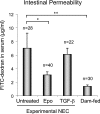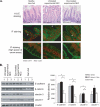Erythropoietin protects intestinal epithelial barrier function and lowers the incidence of experimental neonatal necrotizing enterocolitis
- PMID: 21262973
- PMCID: PMC3069416
- DOI: 10.1074/jbc.M110.154625
Erythropoietin protects intestinal epithelial barrier function and lowers the incidence of experimental neonatal necrotizing enterocolitis
Abstract
The impermeant nature of the intestinal barrier is maintained by tight junctions (TJs) formed between adjacent intestinal epithelial cells. Disruption of TJs and loss of barrier function are associated with a number of gastrointestinal diseases, including neonatal necrotizing enterocolitis (NEC), the leading cause of death from gastrointestinal diseases in preterm infants. Human milk is protective against NEC, and the human milk factor erythropoietin (Epo) has been shown to protect endothelial cell-cell and blood-brain barriers. We hypothesized that Epo may also protect intestinal epithelial barriers, thereby lowering the incidence of NEC. Our data demonstrate that Epo protects enterocyte barrier function by supporting expression of the TJ protein ZO-1. As immaturity is a key factor in NEC, Epo regulation of ZO-1 in the human fetal immature H4 intestinal epithelial cell line was examined and demonstrated Epo-stimulated ZO-1 expression in a dose-dependent manner through the PI3K/Akt pathway. In a rat NEC model, oral administration of Epo lowered the incidence of NEC from 45 to 23% with statistical significance. In addition, Epo treatment protected intestinal barrier function and prevented loss of ZO-1 at the TJs in vivo. These effects were associated with elevated Akt phosphorylation in the intestine. This study reveals a novel role of Epo in the regulation of intestinal epithelial TJs and barrier function and suggests the possible use of enteral Epo as a therapeutic agent for gut diseases.
Figures







Similar articles
-
Erythropoietin protects epithelial cells from excessive autophagy and apoptosis in experimental neonatal necrotizing enterocolitis.PLoS One. 2013 Jul 25;8(7):e69620. doi: 10.1371/journal.pone.0069620. Print 2013. PLoS One. 2013. PMID: 23936061 Free PMC article.
-
Protective Effects of Bifidobacterium on Intestinal Barrier Function in LPS-Induced Enterocyte Barrier Injury of Caco-2 Monolayers and in a Rat NEC Model.PLoS One. 2016 Aug 23;11(8):e0161635. doi: 10.1371/journal.pone.0161635. eCollection 2016. PLoS One. 2016. PMID: 27551722 Free PMC article.
-
L-Glutamine Enhances Tight Junction Integrity by Activating CaMK Kinase 2-AMP-Activated Protein Kinase Signaling in Intestinal Porcine Epithelial Cells.J Nutr. 2016 Mar;146(3):501-8. doi: 10.3945/jn.115.224857. Epub 2016 Feb 10. J Nutr. 2016. PMID: 26865645
-
Early erythropoietin for preventing necrotizing enterocolitis in preterm neonates - an updated meta-analysis.Eur J Pediatr. 2022 May;181(5):1821-1833. doi: 10.1007/s00431-022-04394-y. Epub 2022 Feb 5. Eur J Pediatr. 2022. PMID: 35122138 Review.
-
Heparin-binding EGF-like growth factor (HB-EGF) and necrotizing enterocolitis.Semin Pediatr Surg. 2005 Aug;14(3):167-74. doi: 10.1053/j.sempedsurg.2005.05.005. Semin Pediatr Surg. 2005. PMID: 16084404 Review.
Cited by
-
Microbial therapeutic interventions.Semin Fetal Neonatal Med. 2016 Dec;21(6):418-423. doi: 10.1016/j.siny.2016.04.005. Epub 2016 Apr 25. Semin Fetal Neonatal Med. 2016. PMID: 27133778 Free PMC article. Review.
-
Erythropoietin prevents necrotizing enterocolitis in very preterm infants: a randomized controlled trial.J Transl Med. 2020 Aug 8;18(1):308. doi: 10.1186/s12967-020-02459-w. J Transl Med. 2020. PMID: 32771013 Free PMC article. Clinical Trial.
-
Hyaluronan 35kDa treatment protects mice from Citrobacter rodentium infection and induces epithelial tight junction protein ZO-1 in vivo.Matrix Biol. 2017 Oct;62:28-39. doi: 10.1016/j.matbio.2016.11.001. Epub 2016 Nov 11. Matrix Biol. 2017. PMID: 27845198 Free PMC article.
-
Necrotizing enterocolitis intestinal barrier function protection by antenatal dexamethasone and surfactant-D in a rat model.Pediatr Res. 2021 Oct;90(4):768-775. doi: 10.1038/s41390-020-01334-0. Epub 2021 Jan 19. Pediatr Res. 2021. PMID: 33469185 Free PMC article.
-
Peptidomics Analysis Discloses That Novel Bioactive Peptides Participate in Necrotizing Enterocolitis in a Rat Model.Biomed Res Int. 2020 Dec 31;2020:4705149. doi: 10.1155/2020/4705149. eCollection 2020. Biomed Res Int. 2020. PMID: 33490244 Free PMC article.
References
Publication types
MeSH terms
Substances
Grants and funding
LinkOut - more resources
Full Text Sources
Other Literature Sources
Research Materials

